Plating for the Dental Industry
The dental industry has quickly advanced in the last few centuries, with the most advancement occurring within the last few decades. From new techniques to brand new materials, the dental industry barely resembles the profession as it was even thirty years ago.
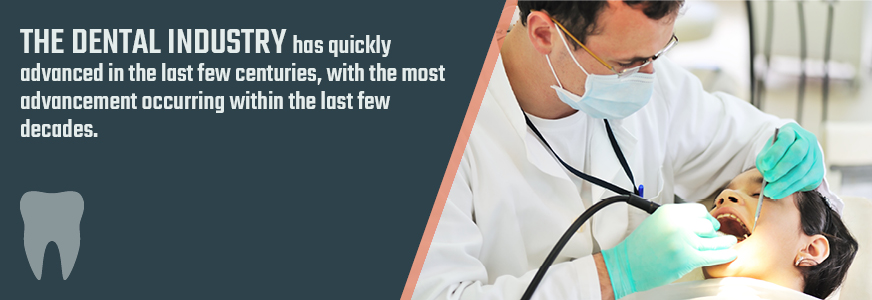
Particularly different is the equipment currently in use – as dental science has advanced, so has the equipment. Metal instruments and implants are now standard throughout the practice, made of metals both precious and common. Certain manufacturing techniques have also become standard in dental device manufacturing to accommodate these advancements, most specifically metal plating.
From cleaning instruments to orthodontic implants, metal plating is now used throughout dentistry to improve upon the natural qualities of base materials used in dental device manufacturing. Devices with improved corrosion resistance, biocompatibility and durability are now commonplace in the industry, making for better smiles and happier, more comfortable patients.
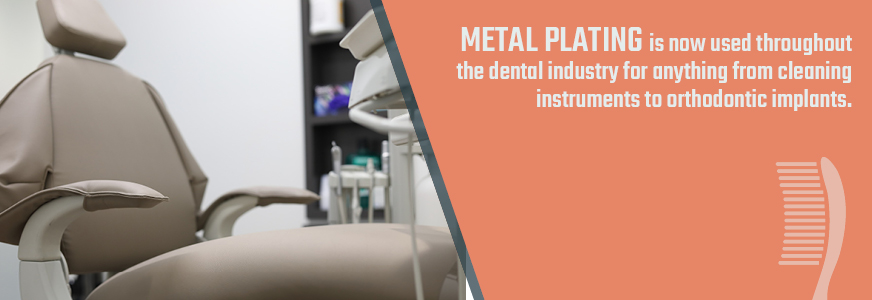
Read on to learn more about the role of plating in the dental industry and how SPC's dental industry plating services can help your company with dental implant manufacturing.
Benefits of Plating in Dentistry
The dental industry uses plating for a wide variety of implants and devices, utilizing the materials to achieve a variety of desirable results. Just a few attributes sought after by the industry include:
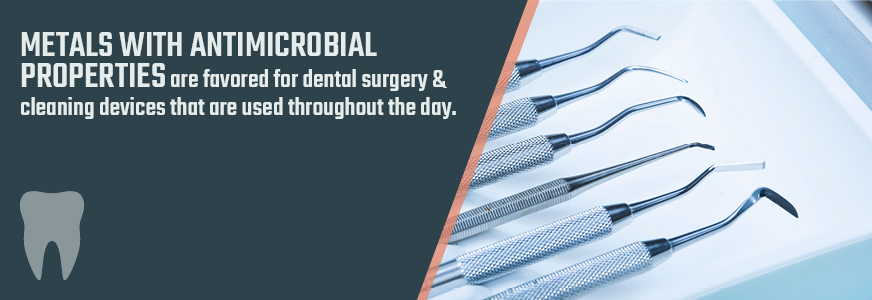
- Sanitation: Sanitation is a big concern for the dental industry because bacterial buildup can lead to serious infections of the mouth and jaw. For this reason, metals with antimicrobial properties are often favored over other options, especially for dental surgery and cleaning devices that are repeatedly used throughout the day.
- Corrosion Protection: Corrosion is of particular concern in dental applications, as the presence of saliva, microorganisms and pH variations in the oral cavity can quickly eat away at metal objects. This is an added concern if the dental device in question is taken out often or if it is removed, cleaned or handled on a daily basis. Many dental devices are plated with non-corrosive metal layers to protect against such corrosion.
- Radiopacity: High-density metals like gold and platinum are radiopaque, meaning that they block radiation from passing through them. Coating medical devices with such materials creates a radiopaque region that appears in x-ray imaging, allowing dental professionals to more easily monitor the status of a patient’s implant without invasive check-ups.
- Biocompatibility: Biocompatibility is one of the most important qualities required of dental materials, as these materials will be in constant contact with a person’s mouth and tissues when implanted in the jaw and gums. While many metals and alloys will react negatively in a biological environment, releasing harmful ions into the body, other metals will guard against such reactions, minimizing any negative effects of the implants.
- Hardness and Durability: Teeth withstand repeated intense pressures as a person talks, eats and goes about their life, making the strength of implants a primary concern. Additionally, dental cleaning and surgical equipment undergo repeated daily use. In both cases, a hard outer coating with that can resist stress is useful.
- Thermal and Electrical Conductivity: Many modern dental cleaning devices use electricity to function. The efficiency of this electrical operation plays a large role in the functionality of the device and can be amplified with the proper connection plating. Additionally, thermal conductivity is a useful attribute in vibrating equipment, as such vibrations can produce excessive amounts of heat, causing discomfort to a patient.
- Pleasing Aesthetics: Aesthetics play a much larger role in dentistry than in other biomedical fields, as a person’s smile can have a lasting effect on their appearance and quality of life. For this reason, implants with pleasing exterior coatings are highly desired, even for the least expensive crown and denture sets.
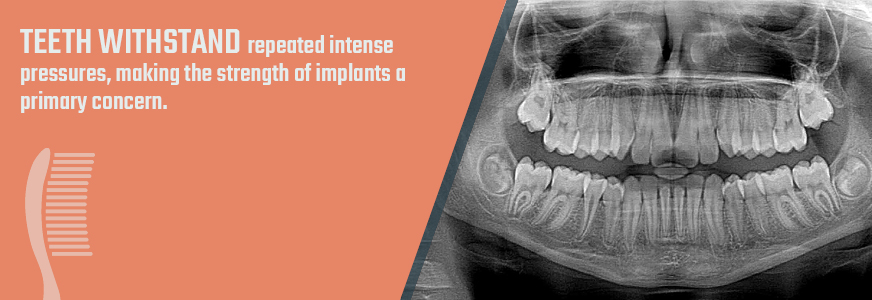
These attributes play a significant role in the dental industry, affecting manufacturers, dentists and patients alike. Manufacturers and dentists benefit from low material costs, while dentists and patients benefit from more sterile and effectual equipment.
On top of these benefits, the plating method used can help achieve the desired results. For example, electroplating is now standard practice for most dental industry plating solutions, depositing a layer a fraction of a millimeter thick. This allows precious metals to be plated onto dental prostheses efficiently and with minimal waste. This keeps materials costs down for dentists and patients alike, minimizing the expense of dental reconstruction surgery, especially for prostheses using more precious materials like gold or platinum.
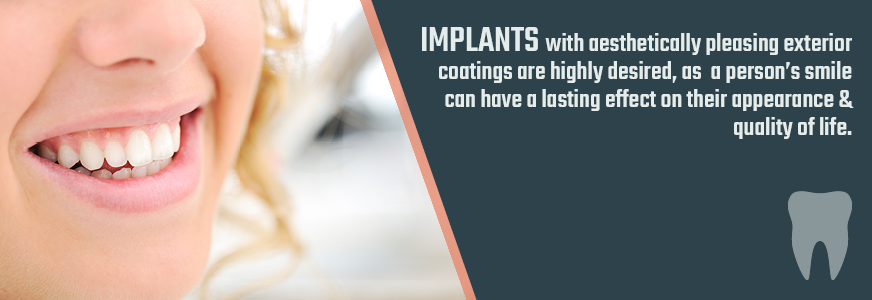
Gold Plating in Dentistry
Gold has been used longer than any other material for dental restoration. The early Phoenicians first used it over four millennia ago by to bind together teeth for aesthetic purposes. The practice continued with the Etruscan and Roman civilizations, creating what is now known as the fixed bridge in dentistry. Though the art form disappeared in the Middle Ages, it was rediscovered and modified in the early 19th century, developing into what it is today. Thus, gold was the foundation of modern dental implants.
Gold's use in dentistry continues to be significant today, with gold crowns and bridges still finding relative popularity among worldwide populations. In fact, the gold plating for fixed dental prostheses is so popular that the dental industry alone consumes about 70 tons of gold annually across the world between pure gold and gold alloy implants. Though alternatives now permeate the market, gold is a well-established plating material throughout the industry and is treated as the industry standard against which other materials are judged. In fact, many practicing dentists name gold as the best restoration material for most applications, favoring it for its multiple benefits, like impressive corrosion resistance, aesthetic appeal and excellent biocompatibility.
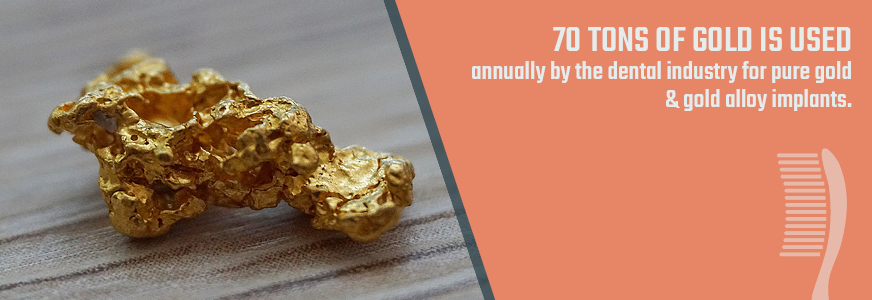
Today, dentists use gold as a plating material, both in its pure and alloyed forms, for tooth restorations, electroformed inlays, partial crowns and metal-supported dentures. It's also commonly used to plate electrical connections in dental surgery equipment since it is also very electrically conductive. At SPC, we offer gold plating using gold that is 99% pure or more, guaranteeing material quality.
Request a free quote
For Dental Plating
Platinum Plating in Dentistry
Dental plating uses several other materials besides gold because of these materials' appearances and functional attributes. One of the most prominent of these is platinum.
Platinum is a much more recent addition to the list of metals used in dental restoration, with its use in dentistry dating back to the mid-1880s in early reconstructive dentistry. This silvery-white precious metal belongs to the same family as palladium and rhodium and was officially discovered in 1735 in Colombia. Named for the Spanish word "platina," meaning silver of little value, Platinum came to be recognized over time as a highly versatile metal, featuring impressive malleability and superior hardness to silver. It's also highly compatible with organic environments like the human mouth, making it ideal for use in dentistry.
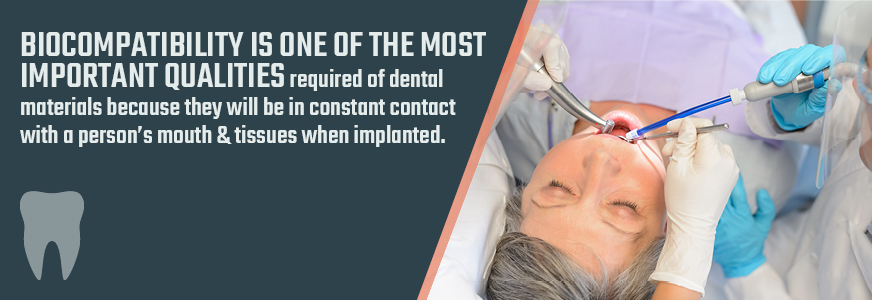
Platinum's biocompatibility comes down to its physical attributes, including resistance to corrosion, oxidization and heat. It's also chemically inert in the human body, meaning that it does not corrode or release allergens in the presence of compounds and chemicals found in the human body. This biocompatibility makes platinum an excellent material for use in dentistry.
Dental professionals often use platinum and its alloys as alternatives to gold for coating dental implants and prosthetic components because of their excellent biocompatibility and pleasing appearance. Dental inlays and bridge restorations are typical applications for platinum within the industry, though the metal is most commonly used to create the core of a dental crown, onto which porcelain is applied to form the tooth prosthetic.
Use of Rhodium on Dental Mirrors
Compared to gold, platinum and palladium, rhodium is less common in the dental industry, though it has left its mark. Rhodium is yet another member of the platinum family of metals, with a similar silver-white color among other attributes. It's primarily obtained as a byproduct of platinum mining and refinement.
Like palladium and platinum, rhodium has several desirable physical properties, including impressive hardness, reflectivity, durability, biocompatibility and corrosion resistance. While it's most commonly used as an alloy for platinum or palladium, rhodium has its own value as a precious metal in the dental and medical industries, serving primarily as a plating material for dental and surgical tools. The material is particularly notable, however, for its exceptional surface quality, producing a finish that's even in color and highly reflective.
Due to the qualities of this metal, rhodium has found numerous uses within the dental industry as a whole. It's most widely recognized in the dental industry as a plating for dental mirrors. Rhodium dental mirrors are exceptional in numerous ways, providing the following benefits:
- Superior reflections, with impressive sharpness and contrast as well as minimal distortion
- Natural, bright color reflectivity, with an optimal reflection spectrum of 90 percent
- A quality of being easy to clean due to excellent surface quality
- A highly sterile nature, yet resistance to corrosion due to disinfection procedures
These qualities make rhodium dental mirrors ideal for routine dental procedures, as well as dental surgeries since they produce nearly perfect reflections that dentists can trust during procedures. These mirrors are also often used when taking intraoral photographs, as the image produced is clear enough to translate to a photographic image.
Contact SPC for more information about rhodium plating for dental mirrors or to get a free quote from us on our plating services.
Palladium Plating in Dentistry
Palladium is another popular option for dental plating. Another member of the Platinum family of metals, this material is the lightest and least noble of the group. Discovered in 1801 as a derivative of platinum, palladium often gets compared to platinum, mostly due to its similar silver-white color and other corresponding physical attributes.
Palladium is significantly less dense than platinum group metals and also features a lower melting point and weight compared to platinum. These differences are insignificant compared to their similarities, especially with regards to biomedical applications. Like platinum, palladium is highly resistant to corrosion and oxidation and is inert when contained within the human body. This makes palladium highly biocompatible for dental applications in both bone and soft tissue environments.
Palladium and its alloys are commonly used in the dental industry, gaining widespread popularity despite how recently they have entered the industry – the first formal dental applications of palladium and palladium alloy took place the late 1970s, nearly a century later than platinum. With its superb corrosion resistance in oral environments, its low price compared to platinum and gold and its aesthetically pleasing appearance, palladium has been a prominent and economical choice in the manufacture of crown and bridge restorations for years. Palladium is also often plated onto titanium implants to protect the surface of the base material.
Applications of Plating in Dentistry
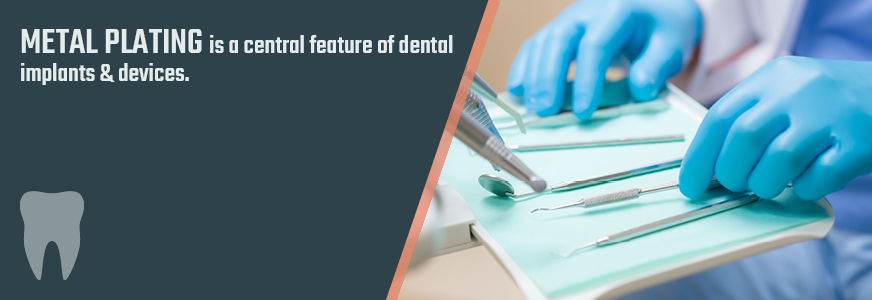
Each of the materials detailed above is used in a variety of specific dental applications, depending on their material strengths and weaknesses and the specific benefits they lend. These benefits have made these materials, and metal plating as a whole, a central feature of dental implants and devices. A few examples of dental plating applications include the following:
- Partial Dentures: Many types of partial dentures contain a metal plate, which spans the top of the mouth and supports any replacement teeth in the assembly. The denture does this by fitting between teeth to help hold the denture teeth and any gum-colored acrylics in place. Typically, either stainless steel or chrome-cobalt makes up the metal framework. Regardless of the material, the framework is often plated with another material like gold to improve corrosion resistance.
- Dental Clasps: Clasps are metallic pieces of wire designed to fit around teeth, keeping removable prosthetics in place throughout the day. Most often, they support retainers and other long-term orthodontic tools.
- Dummy Pontics: A pontic is a dental implant that bridges a gap in the teeth by supporting a replacement tooth, a pontic, with two connected crowns. The crowns sit on either shaved down natural teeth or retaining implants. The base of the pontic is usually metallic, with a stainless-steel base covered by acrylic. Plating is often used for any tooth-facing metallic sides to protect against bacteria and corrosion.
- Maryland Bridges: A Maryland bridge uses a metal framework to support a porcelain tooth, with two metal wings on each side of the replacement tooth. A bonding agent is applied to these wings to stick to the inner side of existing teeth. Often, for aesthetic and corrosion-protection purposes, the metal framework is plated with an additional metal like gold.
- Retention Posts: Also called dental posts, retention posts are installed in the jaw bone to support permanent and semi-permanent dental prosthetics. The base material often consists of titanium or steel, with a plating made of a corrosion-resistant and biocompatible material.
- Orthodontic Implants: Brackets and wires are the main components of any orthodontic process, both of which are expected to last for over two years in an oral environment. Both the base materials and the plating materials used for these components play a crucial role in the longevity and durability of the orthodontic implants, as well as their efficacy in the treatment process.
- Device Housings: Many tools like scopes, dental drills and radiological devices are housed in metal casings to protect their inner workings. Plating is often used on their exteriors to improve durability and corrosion resistance, especially for dental devices enduring repeated use throughout the day.
- Electrical Contacts: Dental professionals often use gold plating on electrical contacts for dental surgery devices. This is both due to gold's electrical conductivity and its resistance to corrosion.
Most of these applications are dental implants, both permanent and semi-permanent versions. With more than 3 million Americans with implants and the number increasing by over 500,000 a year, the dental implant market and the need for quality long-term implants is expanding rapidly.
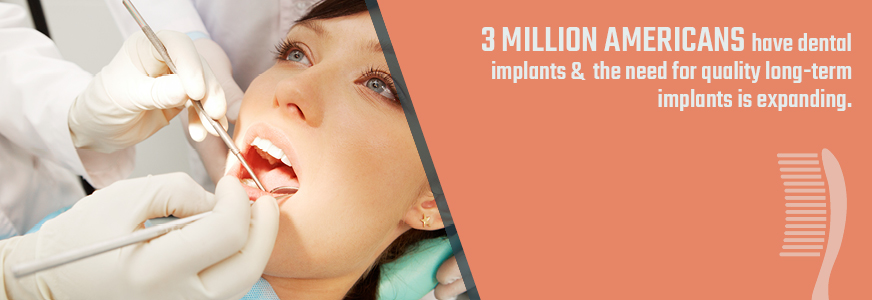
Common Base Materials for Dental Implants
Plating for dental implants involves coating a base material with a thin layer of another material, lending specific properties to the surface of the implant. To understand this process better, you must also understand the base materials used in dental implants. They are described in more detail below:
- Stainless Steel: Stainless steel is a metal alloy that has been used in biomedicine for decades, and is well-established in several branches of medicine, including dentistry. Non-magnetic and very biocompatible, stainless steel is a common alternative to titanium in dentistry, favored for its relatively low cost. The biggest problem with the material, however, is its propensity for corrosion. Stainless steel must be plated with another material to survive well in a biological environment, especially on areas that are not directly attached to bone. Stainless steel is particularly useful as a base material for orthodontics, though it is still in use as a material for long-term dental implants.
- Cobalt-Chromium: Cobalt-chromium alloys are another prevalent material for implants in both medical and dental applications. Compared to stainless steel, the material offers improved corrosion resistance and comparable strength. In fact, when milled into a dental implant framework, cobalt is largely comparable to titanium in terms of fit quality. The primary concern with chromium-cobalt, however, is the allergic reaction some patients have to the material. For this reason, it is commonly plated with non-allergenic metals like gold.
- Titanium: Titanium has been the metal of choice in dentistry for over 35 years. It's so often used in dental implants and orthodontics because of its strength and natural resistance to corrosion. It also tends to be very biocompatible, resulting in minimal adverse effects from living tissue. Titanium alloys like Nickel-Titanium are now commonly used in orthodontic wires and long-term maxillofacial implants as an alternative to stainless steel.
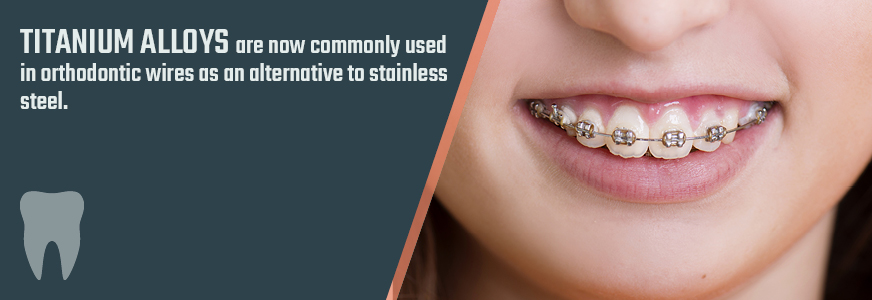
These metals are frequently used to form the primary structure of an implant, establishing and stabilizing the form. A secondary material is often plated on top to lend additional properties to this base material – most commonly, these include biocompatibility and corrosion resistance.
The Future of Plating in the Dental Industry
While plating is already established as a useful process for the dental industry, many advancements are still underway that will make a difference in the future of the industry. You'll find a few examples of current research below:
- Gold Plating on Titanium Alloy: While gold plating onto stainless steel is commonplace and well-established, plating onto nickel-titanium is not. Adhesion between the two materials is still difficult to achieve, but the combination makes for excellent quality orthodontic wires. Research is currently underway to establish a consistent production method for plating gold onto nickel-titanium without creating any voids.
- Zirconia Crowns: While most dental implants are made of metal, many pioneering dentists are turning to all-ceramic crowns and implants, which could reduce the role of plating within the dental implant industry. These implants show lots of promise, offering excellent aesthetic properties and impressive longevity. However, these zirconia crowns only recently passed clinical tests, and have yet to find a stable place in the dental industry. Producing the crowns also require specific CAD techniques, making them extremely expensive. Research is still underway to develop a more affordable method of producing these devices.
- Electroforming: Electroforming technology is similar to electroplating and uses an electrode to deposit homogeneous atoms of gold onto a surface. In dentistry, it is used to create bases for dental reconstructions. The method is quickly gaining traction as a way to quickly create crown and implant bases, but is still under development, as consistent methods of depositing thick metal layers are still under scrutiny.
Dentistry, especially materials science for dental applications, is expected to continue advancing into the future as new implant materials and methods come about. For now, perfecting the methods currently in use is a top priority. For this, dental prosthesis manufacturers need a plating resource they can trust to get the job done correctly every time.
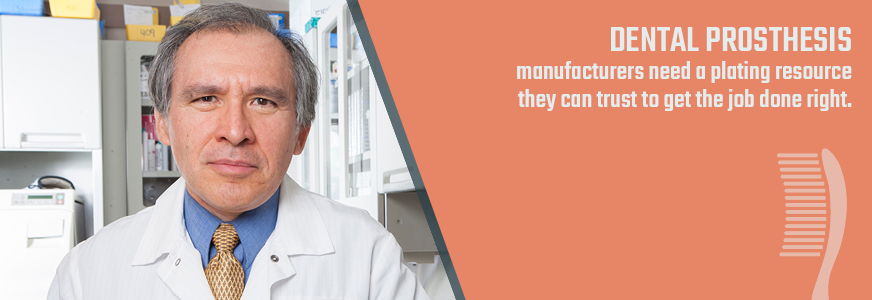
Sharretts Plating Company Can Help with Your Dental Electroplating Services
When it comes to precious metal plating services for the dental industry, Sharretts Plating Company is the best resource available. From palladium plating to gold and silver, we can help provide plating services for dental prostheses manufacturers.
With over nine decades of experience in the industry, SPC is a metal finishing company with extensive expertise and knowledge in precious metal plating services. We guarantee high-quality products every time, with the best gold, silver and platinum platings available on the market. We'll work with your company on a one-on-one basis, having you work with our consultants on-site, editing and suggesting improvements to your design as needed and developing a customized plating plan for your unique application.
SPC places a high priority on our customers, which why we don't just offer plating services – we offer environmentally-minded plating services designed to minimize material waste and environmental impact. We'll even consult with you if you decide to go with another plating provider.
If you're considering a precious metal plating service for your next dental prosthetic project, take a look at what SPC has to offer. Contact us to speak with an experienced plating consultant about your application and what you need in electroplating services, and we'll provide you with a free, no-obligation quote. Start today by visiting our website!
LEARN WHAT OUR MANY SATISFIED CUSTOMERS HAVE TO SAY ABOUT Us
"I would like to thank you for the help you have provided us in developing an electroless nickel plating technique on an unusual substrate. The sample platings you provided show that we should be able to reach our goals. I especially appreciate your willingness to take on an unusual job, with the uncertainties that that entails...We are looking forward to working with you in the future on our plating needs."
– Robert K.



